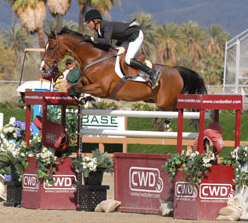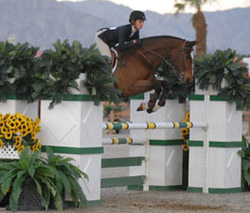By Laura Ware
The newly added championship week at this year’s HITS Desert Circuit brought many exciting new classes. One of them was the prestigious Ronnie Mutch Equitation Classic, which has previously been held at the Winter Equestrian Festival in Florida. To qualify for the classic, riders must have won a USET, USEF, ASPCA Maclay, or WIHS medal class at any of this year’s winter circuits.
This class is unique in that it does not allow the riders to communicate with their trainers during the time that the class is being held. The riders are also judged in the schooling ring. This year’s winner, Carly Anthony, was gracious enough to answer a few questions for us regarding this special class.
Laura: What was the format of the class?
Carly: There were two rounds. The first one was a jumper course that had a very demanding first line which challenged everyone. The judges definitely rewarded the people who took risks. Even if the round wasn’t perfect, they liked the fact that a rider was willing to put it on the line. The second round had tests which were also very difficult. There was no work off, but I believe there would have been if the judges had had more time, because the scores were very close. Laura: What was it like not being able to communicate with your trainers?
Carly: I LOVED IT! It was a great chance to use all that I have learned from my trainers and prove to them that what they teach me doesn’t go in one in ear and out the other; it actually stays in there.
Laura: What was it like to be judged in the schooling ring? I understand that the overall score from your round was adjusted based on the schooling arena judge.
Carly: It was so much fun to be judged in the schooling ring because that’s where it all happens. You get to show the judges what makes you even more unique from the other riders as you school your horse over warm-up fences. They announced the scores when the other scores from your round were announced, and a rider could receive a +4, +2, 0, -2, or -4. I would have to say that was one of the most interesting parts of the class.
Laura: Did you enjoy this type of class?
Carly: This was the most fun class that I have ever competed in. It was a true test of my knowledge, and it was such an amazing experience to prove not only to my trainers, but to myself that I can do this on my own. I really enjoyed riding on my own, and it gave me a little taste of what it will be like when I become a professional. It was an honor to be able to compete in such a wonderful class.
Laura: Thank you so much for your time, Carly, and congratulations on winning the inaugural Ronnie Mutch Equitation Classic on the West Coast. Hopefully we’ll see more of these classes in the future.
Ronnie Mutch was a life-long horseman. An early student of Gordon Wright and Al Homewood, Mutch won the AHSA Medal finals in 1950 at the age of 15. At 18 he was the youngest rider at the time to ride for the USET. By 1970, Mutch had established with his wife, Sue Bauer, one of the most successful show jumping stables in the country, Nimrod Farm. Twenty-eight years after Mutch had won the AHSA Medal Finals, Mutch’s son, Bert, won the Medal Finals. Ronnie and Bert Mutch are the only father and son combination to have won the Medal Finals.
The R.W. Mutch Educational Foundation is a tax exempt 501 (c) (3) educational foundation that sponsors both a scholarship and the annual R.W. (Ronnie) Mutch Equitation Classic. This special invitational class is open only to those young riders who qualify by winning one of the major equitation classes during any of the Winter Circuits, including HITS-Thermal, HITS-AZ, HITS-Ocala, CN-WEF & the Gulf Coast Winter Series. It is a highly sought after honor to be invited to participate.
Past Winners of the Equitation Classic:
2008 – Carly Anthony
2007 – Maria Schaub
2006 – Maria Schaub
2005 – Sloanes Coles
2004 – Brianne Goutal
2003 – Whitney Roper
2002 – Kate Landau
2001 – Brian Walker
2000 – Vanessa Haas
1999 – Sarah Willeman
Laura Listens is brought to you by Laura Ware. Winner of the 2007 LAHSA Junior Medal Finals and a recipient of the 2008 WCAR Jumper Rider Grant, Laura rides with First Field Farm and often trains with Archie Cox. She is very successful in the all three disciplines on her own mounts as well as catch riding other horses.
 Sunday, March 16th
Sunday, March 16th Congratulations also to Tache Rouge and John French on their win in the $10,000 ASG Software Solutions/USHJA International Hunter Derby Classic topping a talented field of handy hunters. Held under the lights in the Grand Prix arena, professionals, amateurs and juniors competed in this special class. Under the scrutiny of four judges, the top 12 horses hunted around two rounds of courses that included a snake option jump, liverpool, trot fence and the anticipated long gallop to the last oxer.
Congratulations also to Tache Rouge and John French on their win in the $10,000 ASG Software Solutions/USHJA International Hunter Derby Classic topping a talented field of handy hunters. Held under the lights in the Grand Prix arena, professionals, amateurs and juniors competed in this special class. Under the scrutiny of four judges, the top 12 horses hunted around two rounds of courses that included a snake option jump, liverpool, trot fence and the anticipated long gallop to the last oxer. We’ve listed the Desert Circuit Champions and Reserve Champions by division below – congratulations to all the exhibitors and we wish you continued success throughout the 2008 show season.
We’ve listed the Desert Circuit Champions and Reserve Champions by division below – congratulations to all the exhibitors and we wish you continued success throughout the 2008 show season.